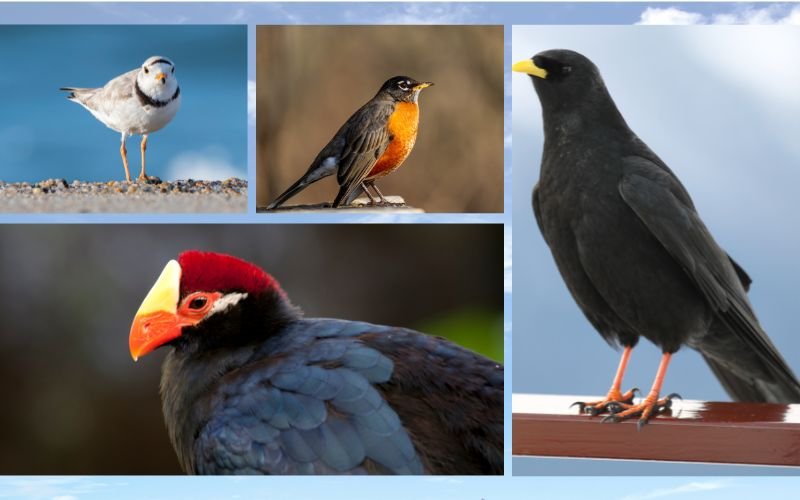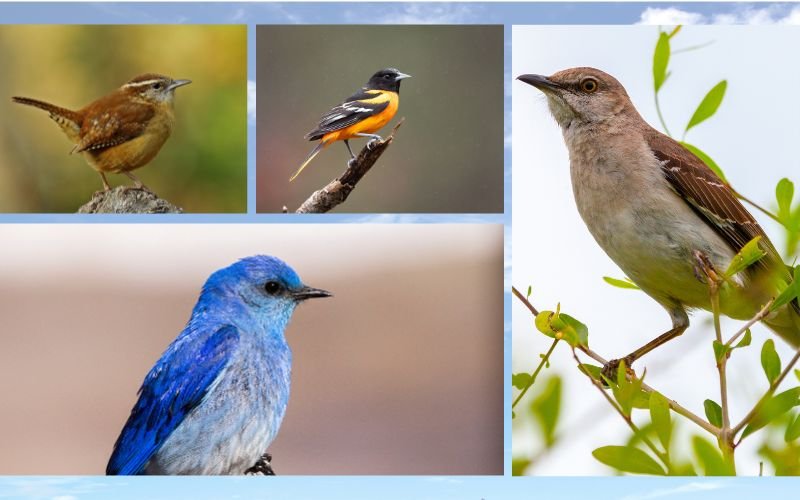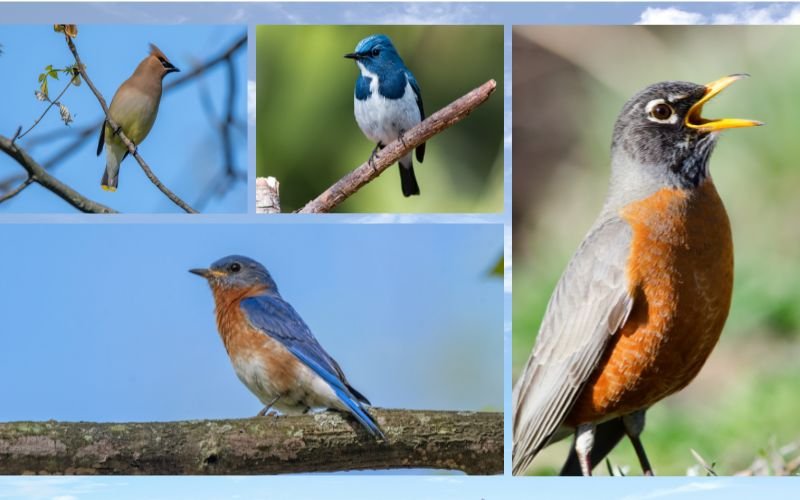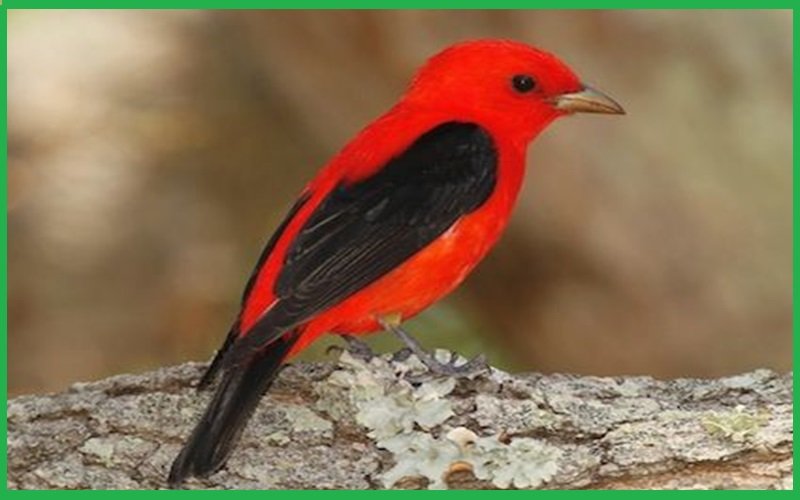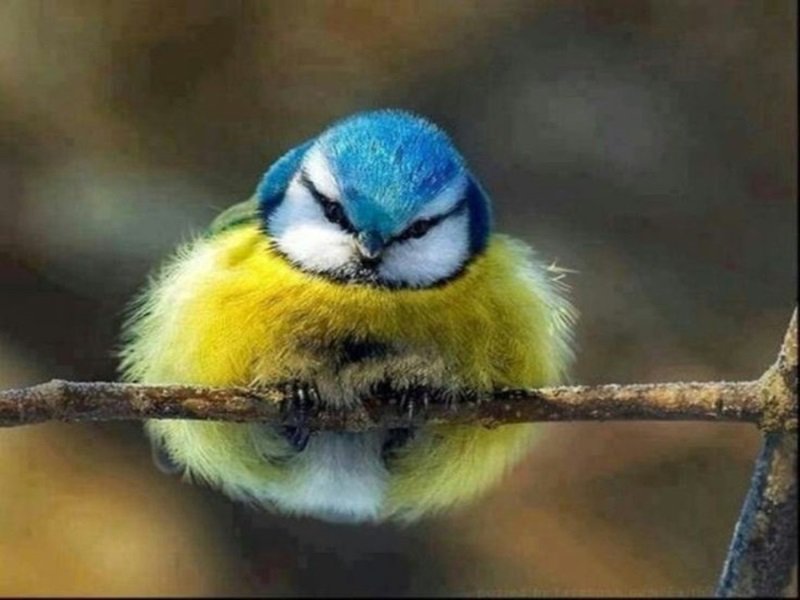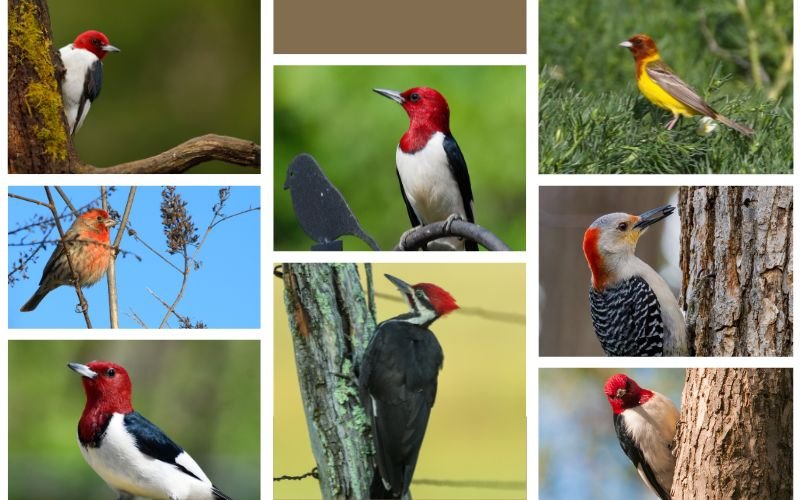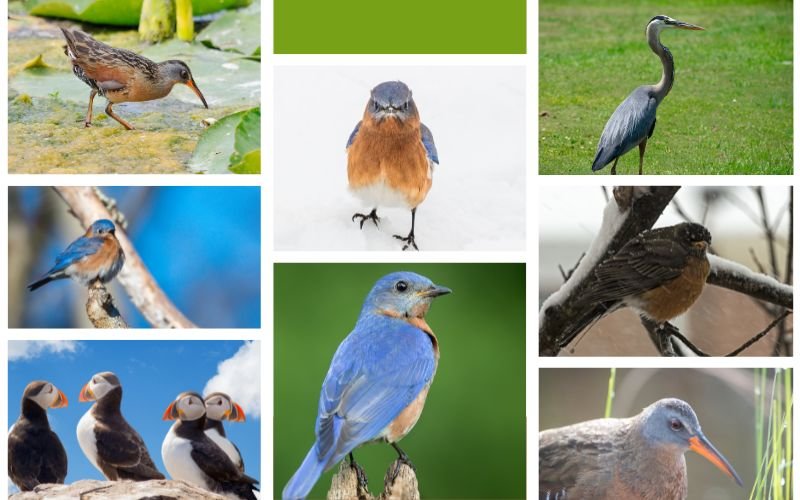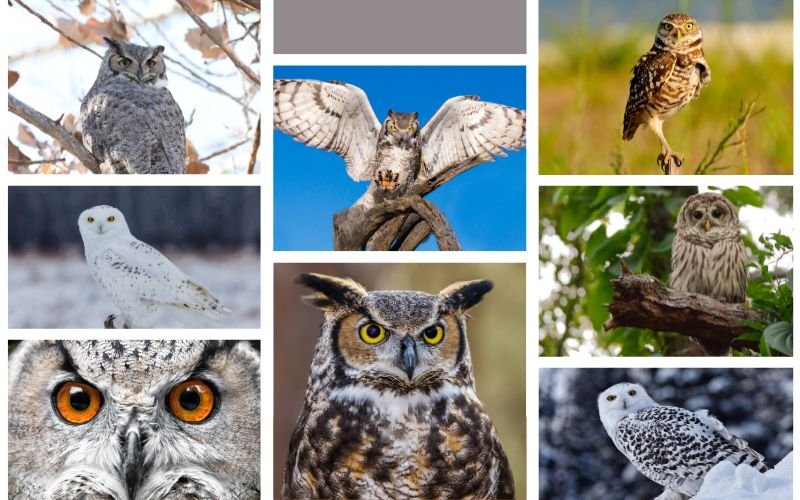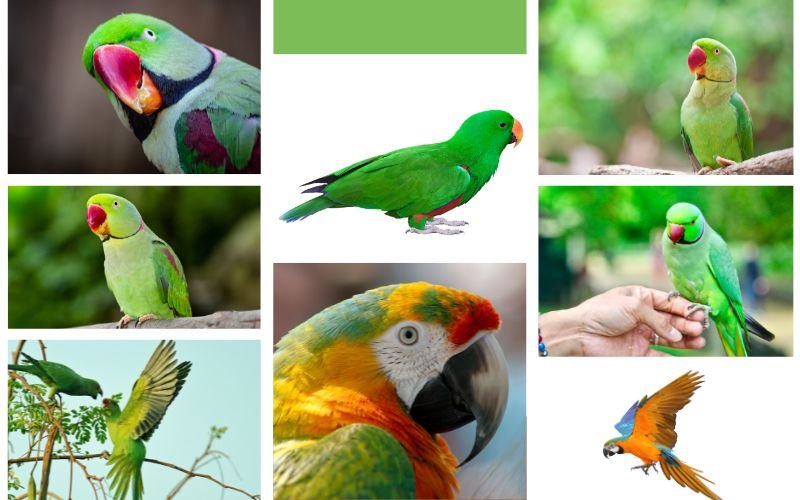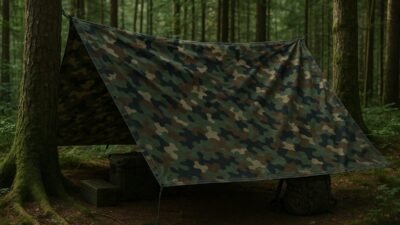In this world of avian species, birds have vibrant color combinations that make their appearances more attractive.
Birds with black plumage and orange beaks are alluring with unique characteristics and adaptability. This article will discuss the top 25 Blackbird species with orange beaks along with their physical description, characteristics, geographic distribution, habitat preferences, and adaptation capabilities of nature.
So let’s dig into their different subspecies and explore their characteristics.
Black Birds With Orange Beaks: An Overview
To have a better understanding we need to have a general idea about these beautiful black birds with orange beaks and their overall characteristics and other elements of nature.
This section will discuss these species’ physical features, distribution, habitats, and feeding habits.
Physical Characteristic
Birds with black plumage and orange beaks are found worldwide in different regions and continents. They are similar in Physical size and shape.
These birds have beautiful matte black or shiny black plumage and an orange highlighting beak on their body. This makes their look even more stunning. The size of the beaks and shapes might vary from different species to species.
Geographic Distribution
Birds with black bodies and orange beaks are seen in many places around the world. Their appearance varies from culture to culture, depending on the given context and regional adaptation.
However, these birds are familiar in South America, North America, Canada, Mexico, New Zealand, Brazil, the Atlantic and Pacific Oceans, the United States, and Florida.
Their characteristic survival depends on their geographic location. Their food habits and habitats also depend on their geographical location.
Habitat Preferences
Each subspecies has different habitat preferences. Some prefer dense forests, while others like grasslands, wetlands, or coastal areas.
Some species also like to live in urban, nonurban, or open farmland habitats. Their feeding habits also depend on their habitats and the location where they build their nests.
Feeding Habit
The feeding habits of these species vary from their sources of their surroundings and habitats. By far most black birds with orange beaks shave similar food habits.
They like eating fruits, flowers, nectars, spiders, snails, fish, krill, earthworms, and berries.
25 Black Birds with Orange Beaks
1. Toco Toucan (Ramphastos)
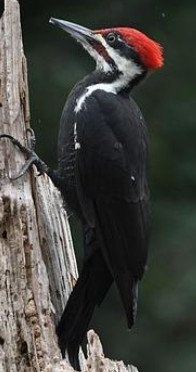
Toco Toucan birds have giant orange beaks with black features. Their throat-to-neck area has white plumage. They weigh 500 g to 900 g. They’re familiar in South America in half-open places for their habitats.
They can be found in Northern and Eastern Bolivia, Peru, Argentina, and some coastal areas. They can be found in half-open places such as woodlands, savanna, and other open fields for their habitats.
These Toco Toucan birds eat small insects, frogs, reptiles, and small birds with their long beaks. Their long beaks also help to maintain their body temperature in balance and expel excessive heat through their bill.
2. Common Blackbird (Turdus merula)
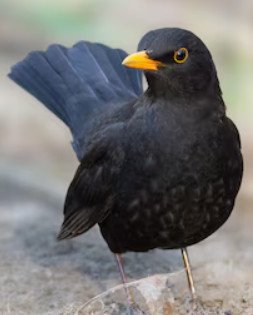
Common blackbirds have glossy black plumage and an average orange beak on their bodies with blackish brown legs. They are mostly familiar with Europe and Asia, which are combined continents of Eurasia.
That is why their other name is Eurasian Black Birds. They can be found in Russia, North Africa, Australia, and New Zealand. They eat seeds, insects, and earthworms.
Male birds protect their territories during breeding while chasing other male birds with threat signs. Male birds bow their heads during courtship with their mates.
3. Indian blackbirds ( Turdus Simillimus )
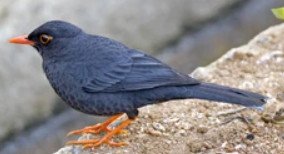
Indian black birds are the subspecies of common blackbirds. However, they are mostly common in India and Sri Lanka. Their size is about 19-20 centimeters long.
They also have a yellow circle or broader around their eye areas with orange legs. They also eat seeds, fruits, and earthworms. They mostly eat what they find on the ground.
4. Common Myna (Acridotheres Tristis)
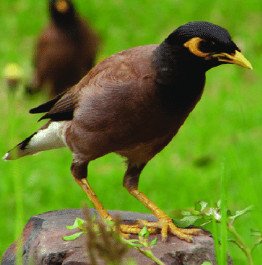
Common Myna is another name for Indian Myna or Myna. They have black glossy heads and brownish bodies with orange beaks. They have little yellow spots beside their eyes.
They are mostly familiar with Asian continents, such as Pakistan, India, Bangladesh, Sri Lanka, Malaysia, Singapore, and Uzbekistan.
Their preferred habitats are open places like woodland, cultivation, and urban and suburban areas. Myna chooses their mates for their lifetime and is mostly seen in pairs.
They eat grass, insects, grains, grasshoppers, fruits, and seeds, which are mostly found on the ground.
5. Black-Breasted Thrush (Turdus Dissimilis)
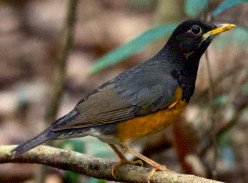
Black-breasted thrushes have black and gray plumage with orange beaks. Their chests or breasts are also orange.
They are familiar with Northern Vietnam, India, and China in hill stations. They eat berries, insects, and mollusks for their food habits.
They mostly try to eat food from the ground. Sometimes, they fly into trees to get some fruit.
6. Crested Anklet ( Aethia Cristatella)
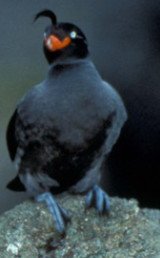
Crested anklets are common seabirds. They have black bodies and small orange beaks, and their forehead features are slightly curved.
They can be familiar with the Bering Sea and Pacific Oceans. They prefer lava flows and sea cliffs for their habitats.
As they are seabirds, they mostly eat krill, small mammals, and fish from the water.
7. Wattled Curassow (Crax Globulosa)
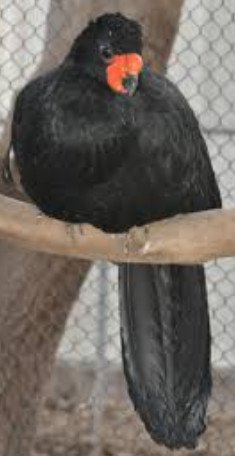
Wattled curassow birds have black bodies and orange-red beaks. The lower part of their body is orange plumage with large feet. They are familiar with Brazil, Colombia, Peru, and Bolivia.
They like tall trees and forests for their habitats. They eat seeds, fruits, and insects. These species face challenges and lose their population because of illegal hunting and deforestation.
8. Black and Gold Cotinga (Lipaugus Ater)
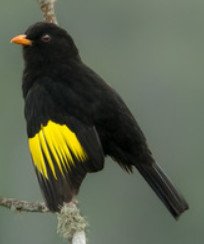
Black and gold cotinga birds are associated with the Cotingidae group. Their body is black and their beak is yellowing orange. They also have a yellow plumage on their wingspan.
They are mostly familiar with the Atlantic forests and Brazil. Male birds have high-tone vocalizations during their courtship days. However, this species is facing challenges because of the loss of its habitats.
9. Hornbill (Bucerotidae)
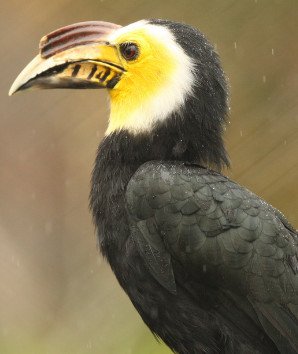
Hornbills have black and white plumage on their bodies and huge orange beaks curved downwards.
These huge beaks help them fight with other birds, catch their prey, and build their nests. Their neck muscles are also strong, balancing these huge beaks.
They are familiar in Indian continents and Africa. They prefer woodlands and savanna places for their habitats. Some prefer dense forest areas to live in. They stay in small groups or pairs.
10. Golden Crested Myna (Ampeliceps Coronatus)
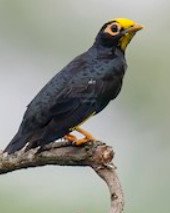
Golden-crested Myna are a subspecies of the Myna family. They have a black body with a yellow head, and their beak is a mix of yellow and orange.
Compared to other birds, these birds can live 15 to 20 years. They eat insects, small fish, lizards, and fruits. They are common in India and Indochina. Some prefer lowland forests, and some prefer dense forests.
11. Surf Scoter (Melanitta perspicillata)
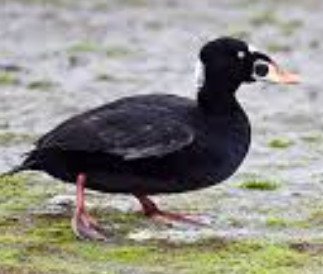
Surf scoter is a large duck which can be found in the sea. They are mostly familiar in North America. Their whole body is velvety black apart from the white patch on the forehead and behind of the neck.
Their beak is a mixture of orange and white. Although they are familiar with North America, they can also be seen in Northern Canada, Alaska, and the Atlantic Ocean. They eat seagrass beds, mussels, crustaceans, and mollusks.
13. Atlantic Puffin (Fratercula Arctica)
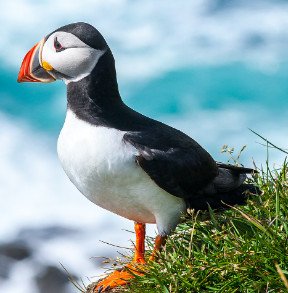
The Atlantic puffin is a sea bird that is familiar in the Atlantic Ocean. It has another name, the common puffin.
Their upper body has black plumage, and their chest or breasts have white plumage. They have beautiful orange-black beaks with orange legs.
They are mostly familiar with Russia, Ireland, Island, and Greenland. They live on shrimp, mollusks, worms, and crustaceans. Puffin birds can catch many fish in one dive water and also can swallow the fish under the water.
14. Variable Oystercatcher ( Haematopus Unicolor)
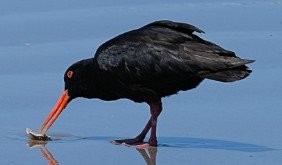
Variable oystercatcher birds have black bodies with long orange beaks and orange legs with red eyes. Their length is around 16 to 18 inches and their weight is around 678 to 724 grams.
They are mostly familiar in New Zealand. These birds are often seen in pairs in the Northland, Peninsula areas. They are fond of sandy areas like beaches.
They build their nests on the seashore between the rocks. They eat worms, small fish, mollusks, and crustaceans. Sometimes, after heavy rain, they go to find earthworms.
15. African Skimmer (Rynchops Flavirostris)
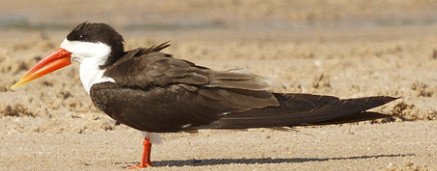
African skimmer birds belong to the skimmer family groups. The back part of the body is black, with half of the head. Their faces and chests are white. They have really long orange beaks and orange legs.
Their life span lasts around 4 to 8 years. They are mostly familiar in Africa and Angola. They are fond of lakes, river areas, and sandy areas.
16. Gray-Winged Black Bird (Turdus Boulboul)
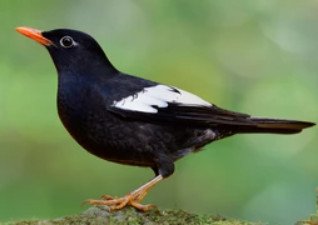
Gray-winged blackbirds have black plumage over their body with orange beaks. Their wings have some white plumage.
They are mostly familiar with the Himalayas, China, and Indochina. During their non-breeding season, they can be found in Myanmar and Thailand.
They mostly eat what they find on the ground, such as insects, eggshells, worms, etc. In winter, they form a group and travel to Pakistan and woodland areas to complete a short migration journey.
17. Javan Myna ( Acridotheres Javanicus)
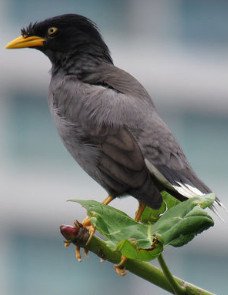
Javan Myna is a subspecies of the Myna bird species. They are also regarded as white-white-vented Myna. Their whole body is black, and their wings are generally brownish black with a little crest on the nose areas.
Their beaks and legs are orange, and their eyes are light yellow. These Jaba Myna birds are mostly familiar in Asian countries. They can be found in Bali and Java in southern Thailand.
They eat seeds, fruits, nectar, insects, and human waste.
18. Snail Kite (Rostrhamus Sociabilis)
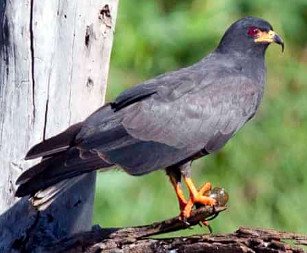
Snail kite birds belong to the kite species of birds. They are generally birds of prey known for their hunting techniques.
The adult male kites have gray-black plumage over their body and sharp orange-black beaks. Their wings are large and broad, which helps them fly faster and longer in the sky.
They are familiar in South America, the Caribbean, the United States, and Florida. They eat crayfish, black crappie, turtles, and crabs.
19. Tufted Puffin ( Fratercula Cirrhata)
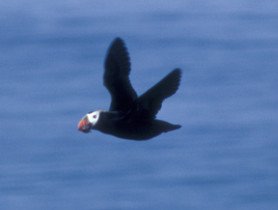
Tufted puffin is also regarded as Crested puffin. They have a black body and white line around their head with orange thick beaks. They are familiar with the North Pacific Oceans.
They go to Washington State, Colombia, and Alaska during their breeding season. They eat fish, squid, krill etc. They can collect many fish and food in their beaks and take them to their child for feeding them.
Foxes are the main predators of these species of puffin.
20. Inca Tern ( Larosterna Inca)
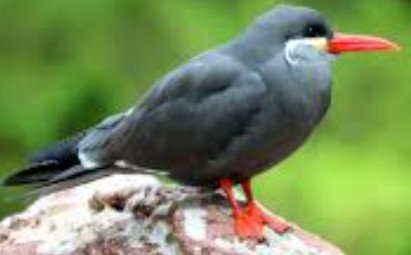
The Inca tern is a medium-sized bird with a gray body and black tail. Their beaks and legs are reddish orange. They also have white lines around their eyes and tail areas.
They are familiar in Central America. They eat small fish, planktonic, crustaceans, and sea lions. They catch their prey with diving skills. They sometimes pick up food or anything from the surface while flying.
21. Abyssinian Scimitarbill ( Rhinopomastus Minor)
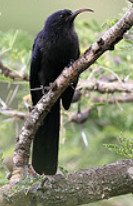
The Abyssinian Scimitarbill is a small bird with black and shiny blue plumage over its body, including on its wings and tail.
They have a sharp and curved orange beak. They are 25 to 39 centimeters tall and weigh 50 to 50 grams. They are familiar with Africa and savanna areas, which have dry woodlands and scrublands.
22. Red-Billed Buffalo Weaver ( Bubalornis Niger)
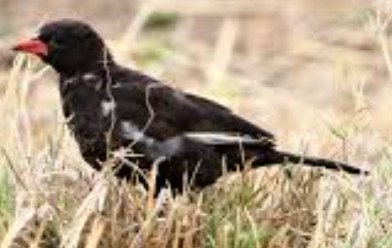
The Red-Bellied Buffalo weaver is a small bird with a black body and orange beaks and legs. It is mostly familiar in Eastern and Southern Africa. The red-belled buffalo weaver’s body length is about 21 to 24 centimeters.
They eat seeds, fruits, insects, grasshoppers, caterpillars, beetles, bees, ants, flies, spiders etc. They are fond of woodlands and savanna areas. These birds live in groups.
They make their nest from tree roots, grass, and leaves.
23. Violet Turaco (Musophaga Violacea)
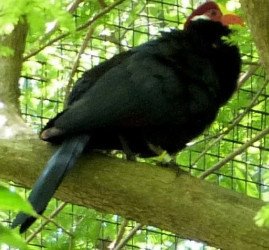
Violet Turaco is a shy bird with black and blue plumage and orange beaks. It is also regarded as a large Turaco bird. It has a small red plumage on its head and a yellow forehead.
They are familiar in South Africa. They are really fond of woodlands, savannas, wetlands, and forest areas for their habitats. They feed buds, flowers, snails, and insects.
They build their nest on trees where female birds lay 2 eggs on their nest.
24. American Robin (Turdus Migratorius)
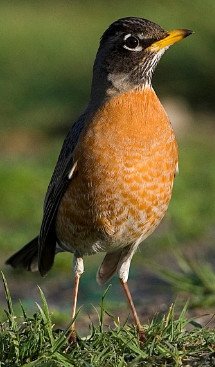
The American bird is a small bird with a black and brown back and an orange chest. Its beak is also orange. Americans are familiar with cities in North America, Canada, Florida, and Mexico.
They spend their winter season in the United States and southern Canada. They are fond of woodlands and farmlands-type areas, which are mostly open areas.
They feed earthworms, berries, insects, and snails for their food. They will sing a song before and after the storms or rains.
25. Green Wood Hoopoe Hoopoe (Phoeniculus Purpureus)
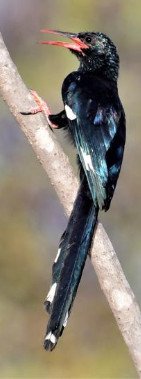
Black-billed wood hoopoe birds are members of wood hoopoe birds. Their body has shiny greenish-black plumage with reddish-orange beaks. They are familiar in Africa.
They choose woodlands and forest areas for their habitats. They eat fruits, seeds, snails, insects, and spiders. During their breeding season, female birds lay two to four blue eggs.
Conclusion
In short, these black birds with orange beaks showcase nature’s vibrant color pattern. They emphasize unique, diverse nature and adaptability through their physical characteristics, distribution, habitats, food habits, and other attributes as well.
There are more birds with vibrant color combinations. For example, you can watch for birds with blue birds with orange chests. These diverse species of nature will encourage you to wonder about their significance on earth.

